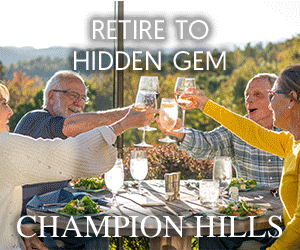Developers of the newest golf course in the Sandhills joke that “one foot of dirt” was moved to build Dormie Club.
While that’s a slight exaggeration and virtually unheard of in today’s “bulldozer age” of golf course design, Dormie Club’s natural setting really is a throwback layout in the ilk of British Open venues.
The course is not extremely long (6,988 from the tips), features wide driving corridors with 94 waste bunkers (no rakes here), and you can virtually roll the ball onto the green from 30-50 yards away on some holes.
The large, expansive putting surfaces, with subtle twists, turns and shelves, can be tricky, while the surrounding green complexes offer a variety of strategic shots that tickle the golf senses.
And no lasers were used on the tee boxes here.
“We have more natural tee boxes,” said Dormie Club membership chairman Mike Phillips. “It gives you the option to find a spot on the tee box that might have a little incline to it in case you want to ‘work’ your drive.”
This is pure golf as Bill Coore and former Masters champion Ben Crenshaw were given free reign of the 1,028 acres of rolling land off of Highway 73 when designing Dormie Club, getting very few marching orders from owner and developer Bob Hansen other than to replicate a bunker or two from legendary courses St. Andrews and Pine Valley – and to design it as a “walking course.” All players must take a caddie or forecaddie.
The land where hunting dogs once roamed and birds were released for sport is special in itself – nestled in an area of the Sandhills where pine forest meets hardwoods with 100 feet of elevation change. Add three lakes (including picturesque 55-acre Coles Lake that can be seen from a few holes on the course) and the magic touch of one of the world’s hottest architectural teams in Coore & Crenshaw and Dormie Club is, well quite frankly, a natural fit and a course many expect to quickly move past some stiff competition in one of the nation’s golfing Meccas.
Coore grew up in North Carolina and attended Wake Forest University, and Crenshaw played in some major championships at Pinehurst Resort, but the pair had no design work to their credit in the Tar Heels state entering 2008. Now in three short years Dormie Club and the recently opened renovation of Pinehurst Course No. 2 has been added to their select resume.
“In the 25 years of our golf course designing we’ve become interested in just two things – the land and the people behind it, and how they want to present golf and what their philosophies are. We look at the natural topography and how that piece of property can yield a golf course,” Crenshaw said.
“We get excited anytime we see sand because sand and golf just go together. That is how the game was born. It means that things are going to drain easier. Sand is vibrant to the eye and sand is natural here in its form.”
There is an innate excitement associated with Dormie Club since it is the first club founded in the area since Forest Creek in 1996 – a span of 15 years.
“A lot of people think our golf market is saturated. Why do you think we need a 44th golf course in Pinehurst? I get that question a lot,” Phillips said. “Well, if we were a middle-of-the-road golf course I would say you are right, you don’t need another. But Pinehurst doesn’t really have a true, high-end private golf club that is not connected to real estate or a resort.
“I hear our course is fair; and that it’s fun – that’s two pretty good accolades right there. And you can talk about how quiet it is out here but it’s one of those things you really have to experience.”
Aside from a few planes flying overhead and some birds chirping during my round, all that was heard was an occasional “good shot” uttered by my caddie. It truly is a treat we often overlook when picking a golf courses since our lives are flooded with outside noise on a daily basis.
“Bill and Ben are like artists because what they show you on their map is not always exactly how it is going to end up,” said Dormie Club head pro Paul Oglesby, who helped oversee the project from start-to-finish. “Bill said until we take some of the trees down I’m not 100 percent sure what it’s going to look like. It’s kind of like working with clay with them.
“Other than a couple of humps and bumps everything you see was basically there,” added Oglesby. “You get a little bit of that Pine Valley feel to it on the back nine. It has quite a different look to it than the beginning part of the golf course.”
By a quirk, the first five holes are all par-4s, but as you ease into your round the thought never enters your mind.
While there is little argument over the appeal of the layout, the course’s plan of becoming an exclusive upscale private golf club has been placed on hold until June 2013 because of a weak economy. That means Dormie Club will be open for limited public play for two years, enabling management to showcase its layout to thousands of area, regional and national golfers who may not have otherwise played the Coore-Crenshaw course.
“You’ve got to change your mindset; you’ve got to switch gears,” Phillips said. “We talked about it a lot. How do we protect our members? How do we not tarnish our image? Down the road will we able to recover from this? Look around the country and a lot of private clubs have slashed their initiation fees and come up with new strategies for people to take a look at their club … or they have gone out of business. We didn’t just grab some figures out of the air. We did a lot of research. We’ve come up with a pretty fair price for our club now.”
And remained true to Hansen’s main slogan: Less is more.
“Bob has always centered everything he did around that concept,” Phillips said. “Things like natural sand cart paths. There aren’t any hard surfaces inside the perimeter of the golf course.
“Dormie Club is a different style of golf course,” added Phillips. “There is nothing else like this in North Carolina. What, Coore and Crenshaw have done just 20 golf courses in the world? They only do a couple per year, so you’re never going to have that flood or Coore-Crenshaw golf courses. There is some exclusivity there. And they have a following, just like the Donald Ross Society. Golfers will search out Crenshaw courses or they will join two or three of them and they’ll make a point to go somewhere to play a Coore-Crenshaw course.”

















